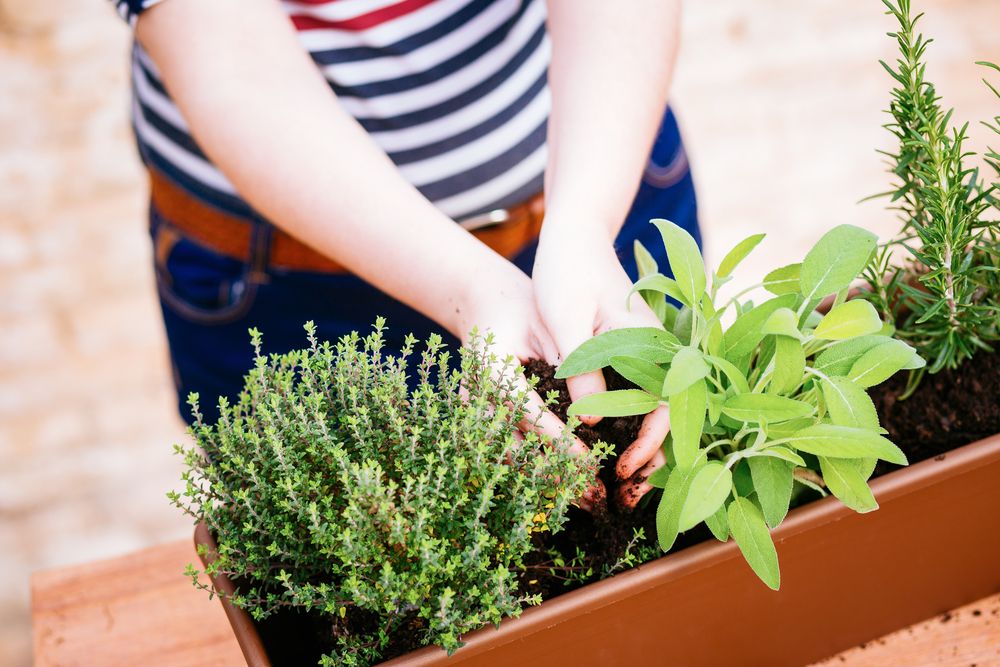8 Herbs & Edible Plants to Grow on Your Balcony

Growing an edible balcony garden is much easier than you think. While a balcony may not be the best spot to grow fruit trees and root vegetables that require huge planters or large spaces, there are plenty of doable options. The key here for first-time gardeners is to start small. There are plenty of easy-going herbs and edible plants that would thrive in pots on a sunny balcony.
Tips for Growing in Containers

With the limited space on a balcony, especially those living in an apartment, planting in pots and containers may be a more suitable option than big raised beds. Here are a few things to pay attention to when growing in containers.
- Choose the right pot (or plant) – Before you start your edible balcony garden, spend some time researching how much space a plant needs. A lot of herbs have relatively shallow roots, which make them perfect for growing in smaller containers on your balcony. Herbs like basil and thyme will do well in 10” deep pots. Whereas garlic, despite its fairly shallow roots, will need space to stretch out in the soil, so you may need pots that are at least 10” wide and 18” to 20” deep.
- Water frequently – Plants in pots need watering more frequently because they dry out more easily than those grown in the ground. Be sure to check on your plants daily. You may have to water your plants once, or even twice, a day. Keep the soil moist with frequent light watering and good drainage.
- Fertilise regularly – You will need to fertilise your edibles regularly to keep them in top form and maximise yield all summer. Choose an organic, slow-release fertiliser that can provide a constant source of nutrients for your plants.
8 Easy Edible Plants & Herbs to Grow at Home
1) Basil

Basil is one of the most common herbs in the kitchen so it’s handy to always have some on hand. It’s easy to grow from seeds and cuttings from store-bought basil. Basil loves warmth and water and does best in well-drained soil with a neutral pH. While it can tolerate temperatures down to 10°C, it thrives between 21°C and 32°C. As an annual plant, basil usually dies once it blooms. One trick to prolong the plant’s life is to pinch back flowers as they form. Doing so also encourages lusher foliage. This aromatic herb is a great companion plant for tomatoes as it repels pests like tomato hornworms, lowering the chances of damage to your harvest.
2) Thyme

Thyme is another versatile herb that can be handy for homecooks. The hardy evergreen plant will give you a year-round supply of fresh thyme. Be sure to pick a culinary thyme like the French thyme, lemon thyme and caraway thyme. There are ornamental varieties that cannot be eaten. Thyme likes well-drained soil with pH between 6 and 8, and needs plenty of sunlight. The optimal temperature is between 20°C and 30°C. This woody perennial herb is drought-resistant and likes their soil on the dryer and looser side, so only water when the soil is dry. The great thing about thyme is that it tastes great dry and fresh, so don’t worry about clipping its sprigs, in fact, regular pruning can encourage growth and a rounder lusher shape.
3) Mint

Another easy herb to grow at home for new gardeners are those in the mint family. Mint prefers partial shade and moist, well-drained and slightly acidic soil with a pH between 6.5 and 7. It depends on the variety you’re growing, but most mints like sunny days and cool nights and do well in temperatures between 13°C and 24°C. Keep in mind that mint tends to spread quickly, so it is best to grow it in a separate pot on its own so as to contain it.
4) Lemongrass

This easy-going perennial tropical plant is frequently used in Asian cuisine to add a zesty, citrus flavour. It is also sometimes grown as an ornamental grass. Lemongrass prefers rich, loamy, neutral soil and loves the summer heat and humid climates. A minimum of 6 hours of direct sunlight per day is ideal. If a live potted plant isn’t available in your nearby garden centre, you can easily grow one from grocery store-bought cuttings. Simply put the stalks in water and wait for them to develop roots before transferring to a pot. An added benefit of having lemongrass on your balcony is that the plant contains citronella, a natural oil that can repel mosquitoes and ticks.
5) Garlic

Consider a vegetable, garlic is one of the easiest edible plants to grow from your balcony garden. Although supermarket-bought garlic is very accessible, they sometimes make poor seeds as they may have already been treated with a sprout inhibitor and therefore may not grow or produce very small bulbs. That is why it is best to seek garlic bulbs that are specifically for planting. Plant your garlic in late autumn so that the plant can develop roots over winter and start sprouting in spring for a summer harvest. When planting, make sure to keep each clove at least 2” apart and in well-drained soil as garlic is prone to fungal root diseases. Place the pot in a pot that receives 6 to 8 hours of sunlight a day.
6) Strawberries

Up your gardening game by adding fruits to your edible balcony garden. Strawberries do well in almost any type of container with proper drainage and will thrive on a sunny balcony between the temperature of 15°C and 25°C. Since it takes up very little space and can even be grown in hanging baskets, it’s a great addition to small homes. This perennial plant prefers rich soil that is slightly acidic with a pH between 5.5 and 6.5. Ideally, you will want your strawberries to get ten hours of sunlight each day, but six hours would be the minimum. To maximise yield from a container-grown plant, use a slow-release organic fertiliser to give your plant enough nutrients to produce fruit.
7) Chillies

Chillies are a family of perennial plants that thrive in tropical and subtropical areas. Chilli peppers love full, direct sun and warmth, they do well with around 5 hours of sunlight each day and temperatures between 21°C and 32°C. Keep the soil constantly moist but not soaked. Do not let the pot dry out completely. Although chillies are perennial, they typically don’t survive cold winter temperatures, so people living in colder areas tend to plant them as annuals. Alternatively, you can bring your chilli plant indoors during winter. Then, prune the plant, leave around 10 to 15cm of the healthy main stem. Find a dry, cool spot near a window where the temperature can stay around 13°C. Water sparsely. It could be as little as 2 to 4 weeks, or only when the soil begins to dry out.
8) Cherry tomatoes

Cherry tomatoes have relatively few requirements compared to many other types of fruits. They are happy in a well-ventilated spot where they can get at least six hours of full sunlight each day between 19°C and 30°C. In terms of soil requirements, most varieties prefer well-drained, loamy soil with a pH of 6.2 to 6.5. If you have very limited space, look for bush tomato varieties as they are more compact, staying 3 to 4 feet tall. Whereas vining varieties can grow much taller and require proper support like a tomato cage, taking up a lot more space.
For those who live an urban life, gardening is a great way to reconnect with nature. It is also a mood booster that can help alleviate stress and a way to get some vitamin D out in the sun. Plus, what’s not to love about having fresh produce literally right outside your window?
At Lanson Place, our guests’ wellness and wellbeing is always at the top of our minds. Many of our long-stay serviced apartments, like those in Lanson Place Waterfront Suites Hong Kong, Lanson Place Aroma Garden Shanghai, and Lanson Place One Sunland Shanghai, boast an airy, sunny balcony or a rooftop deck that our guests can enjoy a bit of sunshine and nurture their green thumbs. Learn more about our spaces.


